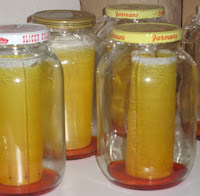This week I am checking ML's for the first time. This is a two day process because after putting all the pretty little dots of wine on the lovely white paper I have to put the paper in a jar of

chromatography solvent. It then sits for eight hours, the chromo solvent slowly working its way up the paper. The next step is to pull it out and let the paper dry over night and finally the next day the separated dots are ready to be read. Some of you might remember this from high school chemistry class. In our class, we put dots on the paper from various black felt tip pens and then looked at the separation of the colors that occurred. Ring any bells? In this case I use capillary tubes to put the dots on the paper. Ideally all the dots end up the same size and are well centered. Don't look at my dots too closely! ;-)
Everything in barrel gets checked for ML i.e. Chardonnay, Marechal Foch and Pinot noir. Hopefully everything will be done by the end of February but there are always a few lagging barrels. I am sure you will get to read about that later.
For those of you unfamiliar with ML: It is a bacteria fermentation rather that a yeast fermentation that coverts malic acid, like that found in green apples to lactic acid, like that found in milk. Winemakers tend to have wines which are to be barrel aged go through the process because of a shift in pH that occurs which increases mouth-feel and approachability in wines. Especially young wines are very tart, at least here in the Willamette Valley and this helps address that acidity. White wines made in tank and intended to be drunk chilled rarely go though ML. In whites I want that extra bit of brightness.
 chromatography solvent. It then sits for eight hours, the chromo solvent slowly working its way up the paper. The next step is to pull it out and let the paper dry over night and finally the next day the separated dots are ready to be read. Some of you might remember this from high school chemistry class. In our class, we put dots on the paper from various black felt tip pens and then looked at the separation of the colors that occurred. Ring any bells? In this case I use capillary tubes to put the dots on the paper. Ideally all the dots end up the same size and are well centered. Don't look at my dots too closely! ;-)
chromatography solvent. It then sits for eight hours, the chromo solvent slowly working its way up the paper. The next step is to pull it out and let the paper dry over night and finally the next day the separated dots are ready to be read. Some of you might remember this from high school chemistry class. In our class, we put dots on the paper from various black felt tip pens and then looked at the separation of the colors that occurred. Ring any bells? In this case I use capillary tubes to put the dots on the paper. Ideally all the dots end up the same size and are well centered. Don't look at my dots too closely! ;-)





No comments:
Post a Comment